One of my favorite cuisines is rustic Italian cooking, and these Tuscan Stewed Beans are my latest favorite iteration.
A handful of simple, budget-friendly and pantry-friendly ingredients like onions, carrots, garlic, fresh herbs, and canned tomatoes are cooked down until sweet and jammy; cannellini beans are later added to the mix and stewed until rich, almost creamy, and unbelievably flavorful.
This recipe will have your kitchen smelling like an Italian restaurant and is guaranteed to become a new cold weather favorite.
Table of Contents
1. What are Tuscan Stewed Beans?
2. Why you’ll love this recipe
3. Ingredient notes
4. Step-by-step instructions
5. Tips for making this recipe
6. Frequently Asked Questions
7. Recipe card with notes
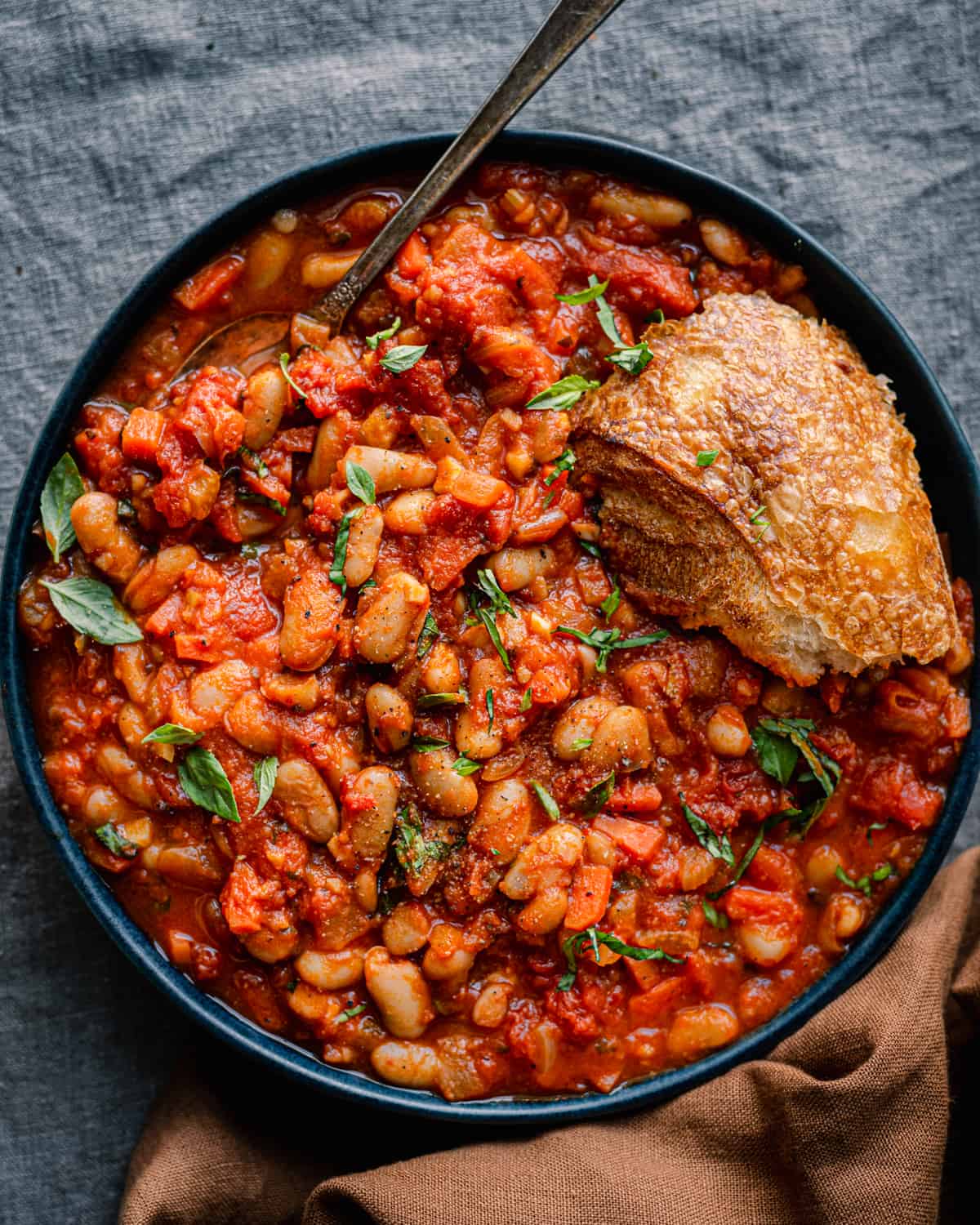
What are Tuscan Stewed Beans??
Well, it’s an incredibly delicious Italian recipe I made up…sort of!
The inspiration for this recipe comes from the TV show Searching For Italy, where the fabulous Stanley Tucci explores his Italian heritage through the regional cuisines of Italy.
While most of the food featured on this show is far from vegan, I love seeing how much care Italian chefs and farmers put into their ingredients and their craft. Every time I watch an episode, I’m excited to make something inspired by the show but with my own plant-based spin.
Episode 5 finds Stanley Tucci in Livorno—a port city on the the west coast of Tuscany —where he enjoys a seafood tomato stew made with very simple but good-quality ingredients. My plant-based interpretation of that dish is a bit loose, as I’m not trying to recreate the taste or texture of seafood.
But based on the ingredients and my subsequent research, I think this recipe does a pretty good job at bringing the flavors from Livorno to your home kitchen.
And when I say it’s honest-to-good freakin’ delicious and one of my favorite bean recipes, I am not kidding. And the ingredients are so simple and humble.

Why you’ll love this recipe
A Wholesome Hug in a Bowl
This is the kind of winter food that makes you feel cozy inside. Every bite feels like a bit of Italian indulgence, but it’s made with wholesome plant-based ingredients: beans, aromatics, garlic, herbs, tomatoes, olive oil, and vegetable broth. Okay, and a little white wine!
Despite being wholesome, the texture is jammy, rich, and so comforting.
Rich Italian Flavor
This recipe starts by cooking down onions until nicely golden, which builds a first layer of flavor. Carrots and celery are then added, along with lots of garlic and chili flakes for a subtle heat.
Fresh sage perfumes the whole stew with a woodsy, camphory aroma, and cooking down a generous amount of tomato paste adds so much umami. Slow simmering infuses the dish with so much flavor.
The resulting flavor is everything you love about homey Italian cooking with a sweet-tangy tomato flavor and lots of herby notes.
Allergen-Friendly, Meal Prep Friendly, and Freezer Friendly
This recipe is vegan, gluten-free, nut-free, and soy-free. Plus, these stewed beans are a great option for meal prep and freeze beautifully!
If you love the sound of pantry-friendly Italian meals, be sure to check out my 10-ingredient Lentil Bolognese and my Italian White Bean and Pasta Stew!
And if you have my cookbook, The Vegan Instant Pot Cookbook, there’s a great easy recipe for Ribollita, which is a pantry-friendly Tuscan bread soup.
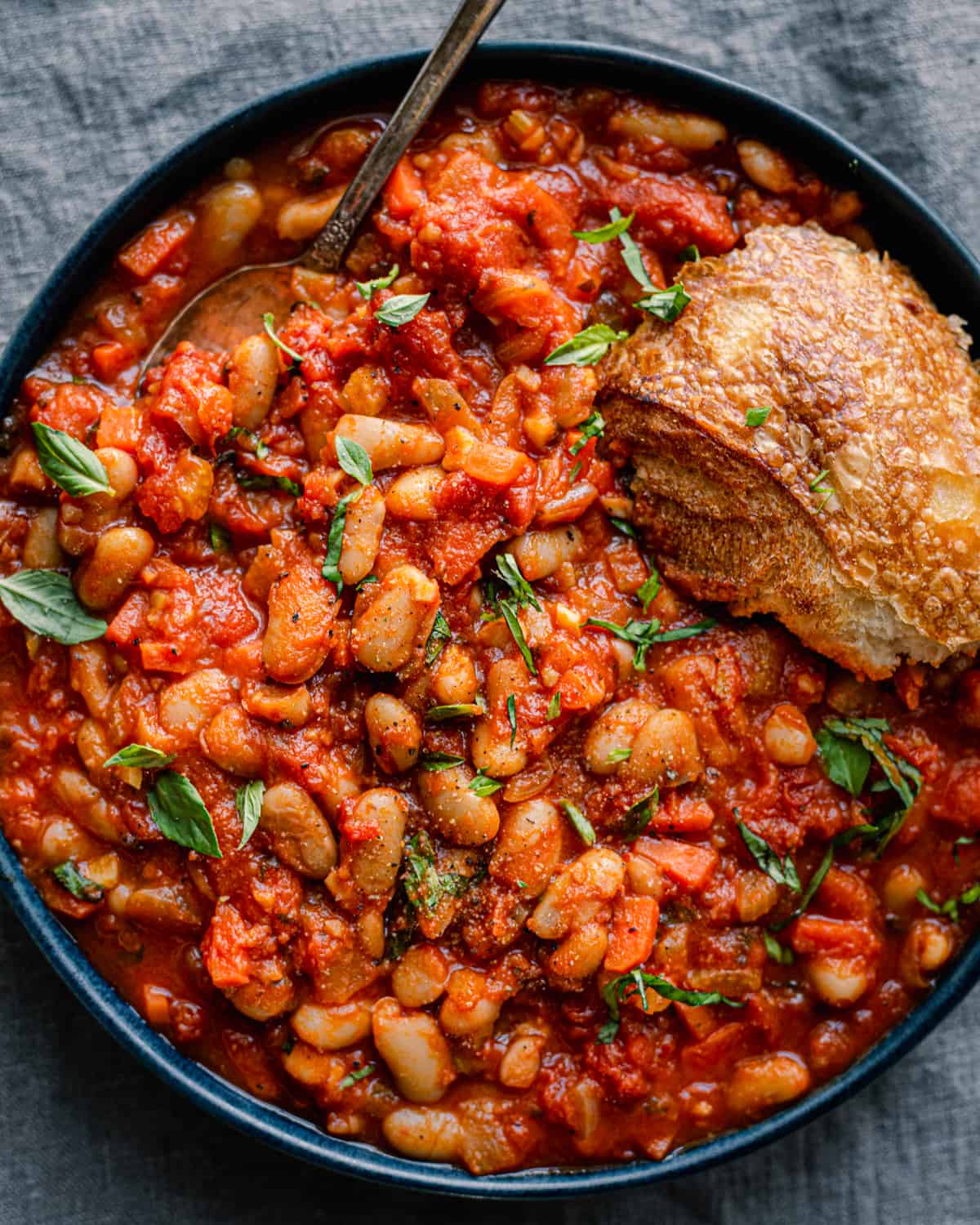
Ingredient notes
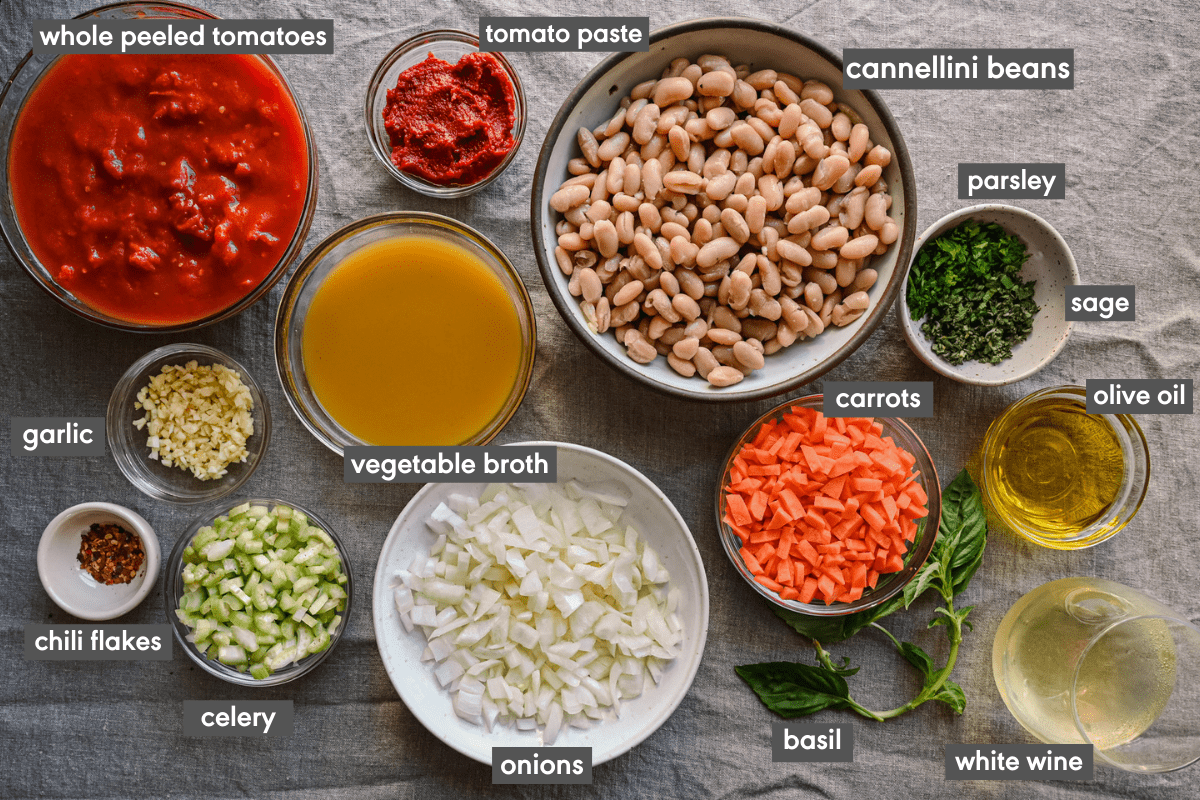
Soffritto. A traditional northern Italian soffritto is used here as the flavor base: onions, carrots, and celery, gently sauteed in olive oil. Many Italian soups and stews, like minestrone, as well as pasta sauces and braised dishes start with a soffritto.
Garlic and Fresh Herbs. Many variations of soffritto add additional aromatics like garlic and fresh herbs like parsley, sage, or rosemary. Luckily, I love garlic and fresh herbs and will add them to almost anything I can.
Substitute: If you can’t find fresh sage, use fresh rosemary. Dried herbs will add significantly less flavor, so use them only if you don’t have access to fresh herbs.
Cannellini beans. The king of creamy beans, cannellini beans work so well here, adding a creamy, almost indulgent vibe.
Substitute: Depending on where you live, these may be sold as “white kidney beans.” If you can’t find them, use any other white bean you like.
Dry white wine. The compounds in alcohol unleash flavor compounds in the aromatics and tomatoes that would otherwise remain hidden, adding complexity to these stewed beans.
Pick a dry, crisp white wine such as Pinot Gris, Sauvignon Blanc, Chablis, Sancerre, Pinot Grigio. To check if your wine is vegan, you can use Barnivore.com.
Substitute: Don’t drink wine? Skip to the FAQ section.
Tomato paste. More precisely, tomato paste in a tube, not a can (if you can!).
Tomato paste in a can has a subtle metallic taste, and since a generous quantity is used in this recipe, that tinny flavor will be noticeable.
Plus, tomato paste in tubes is preserved with salt instead of citric acid, so the tomato flavor is brighter, fresher, and purer.
Whole peeled canned tomatoes. I prefer using whole peeled canned tomatoes for a couple reasons.
Whole peeled tomatoes are 100% tomatoes, nothing else, so the flavor is better. In contrast, pre-diced and pre-crushed varieties have certain additives. For instance, diced tomatoes typically have calcium chloride, which makes them difficult to dissolve and break down.
So you get better flavor and texture with whole peeled tomatoes, and since this is a tomato-heavy dish with fairly minimal ingredients, the quality of the tomatoes is important.
Step-by-step instructions
Heat the olive oil in a Dutch oven or soup pot over medium heat. Sauté the onion with a pinch of salt until golden, 7-8 minutes.
Stir in the carrot, celery, and garlic and cook 3-4 minutes.

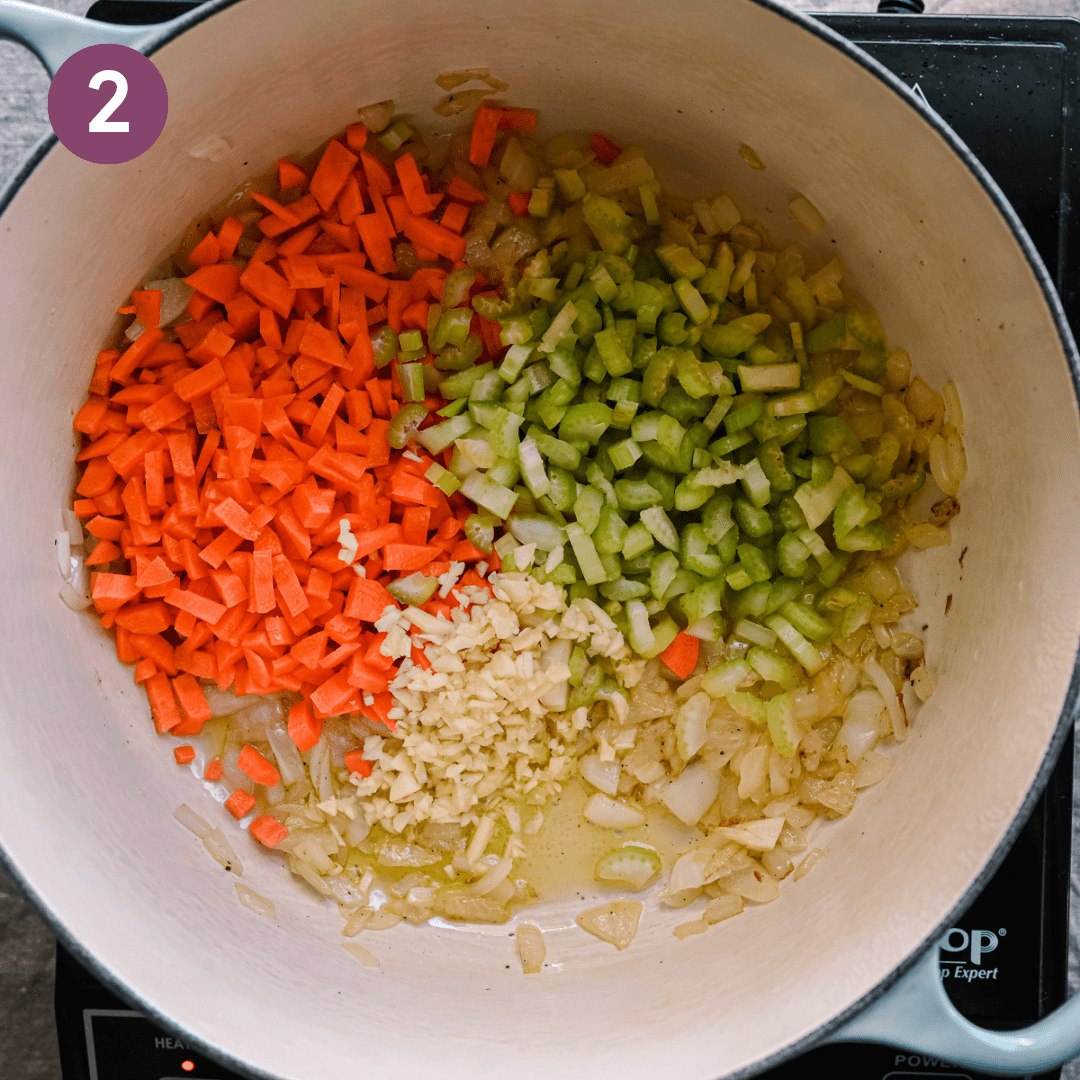
Add the parsley & sage and chile flakes and cook for 1 minute.
Then squeeze in the tomato paste and stir almost constantly for 2 minutes.
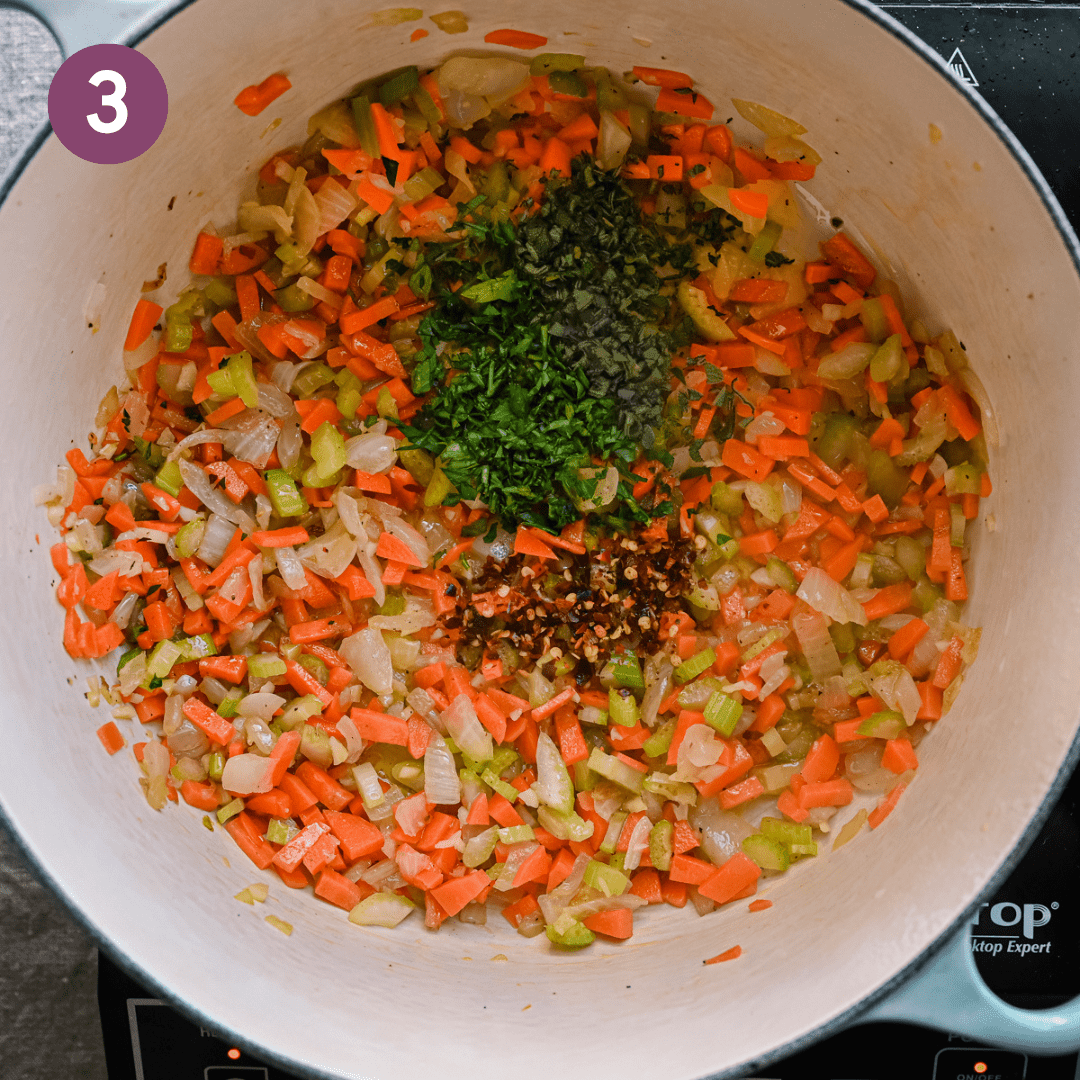
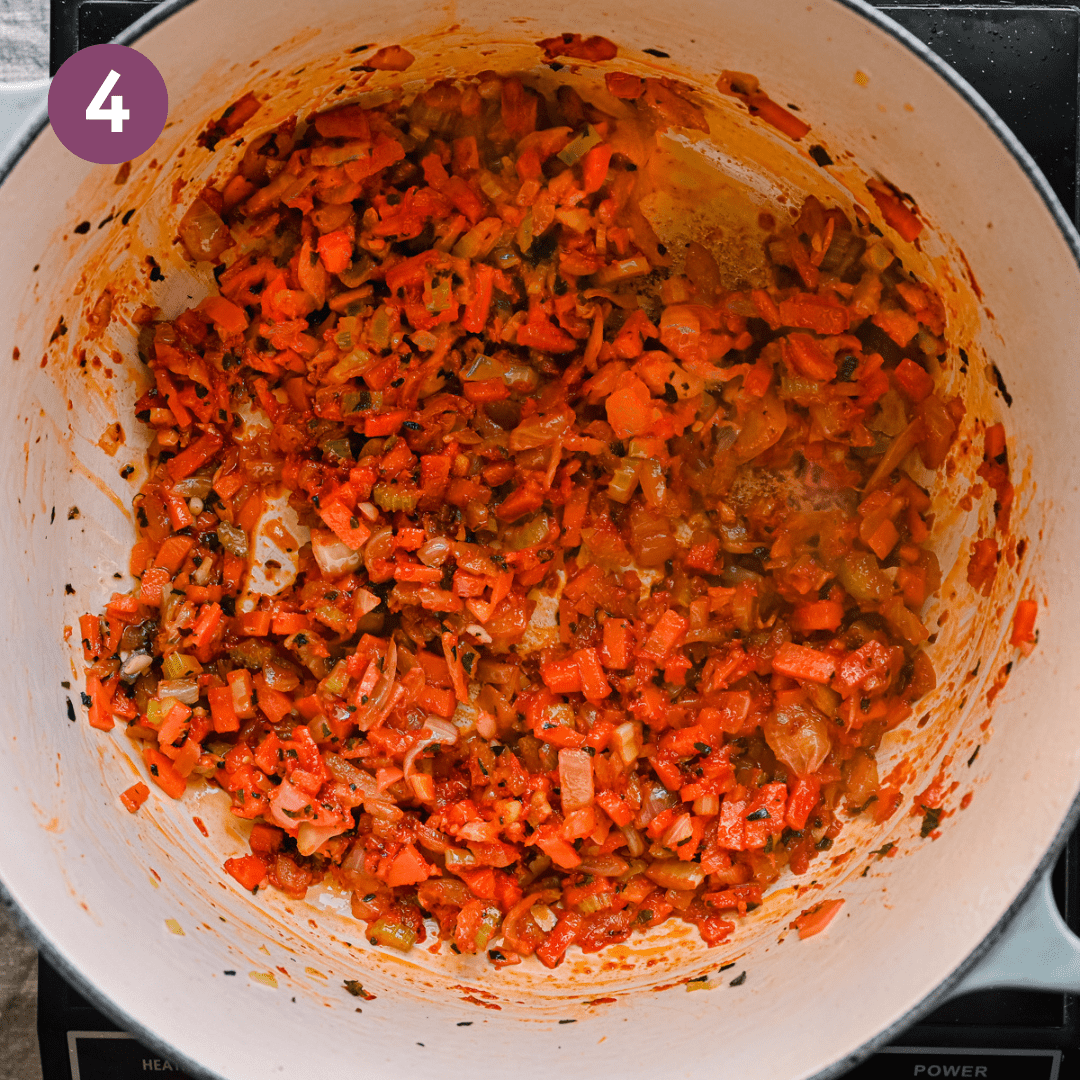
Pour in the white wine and scrape up any browned bits, and cook until the smell of alcohol wears off.
Pour in the crushed tomatoes with their juices, bay leaf, and season with salt and pepper.
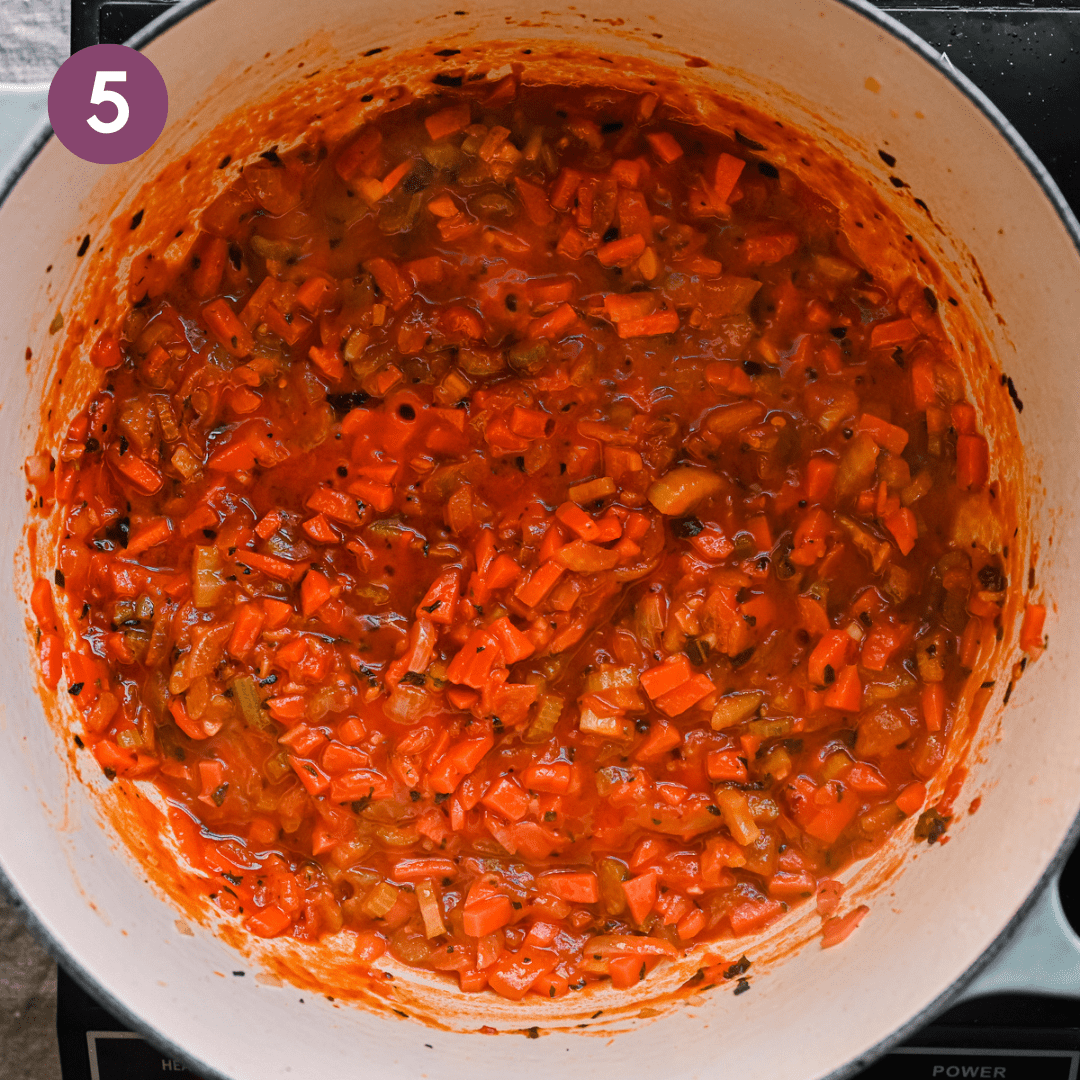
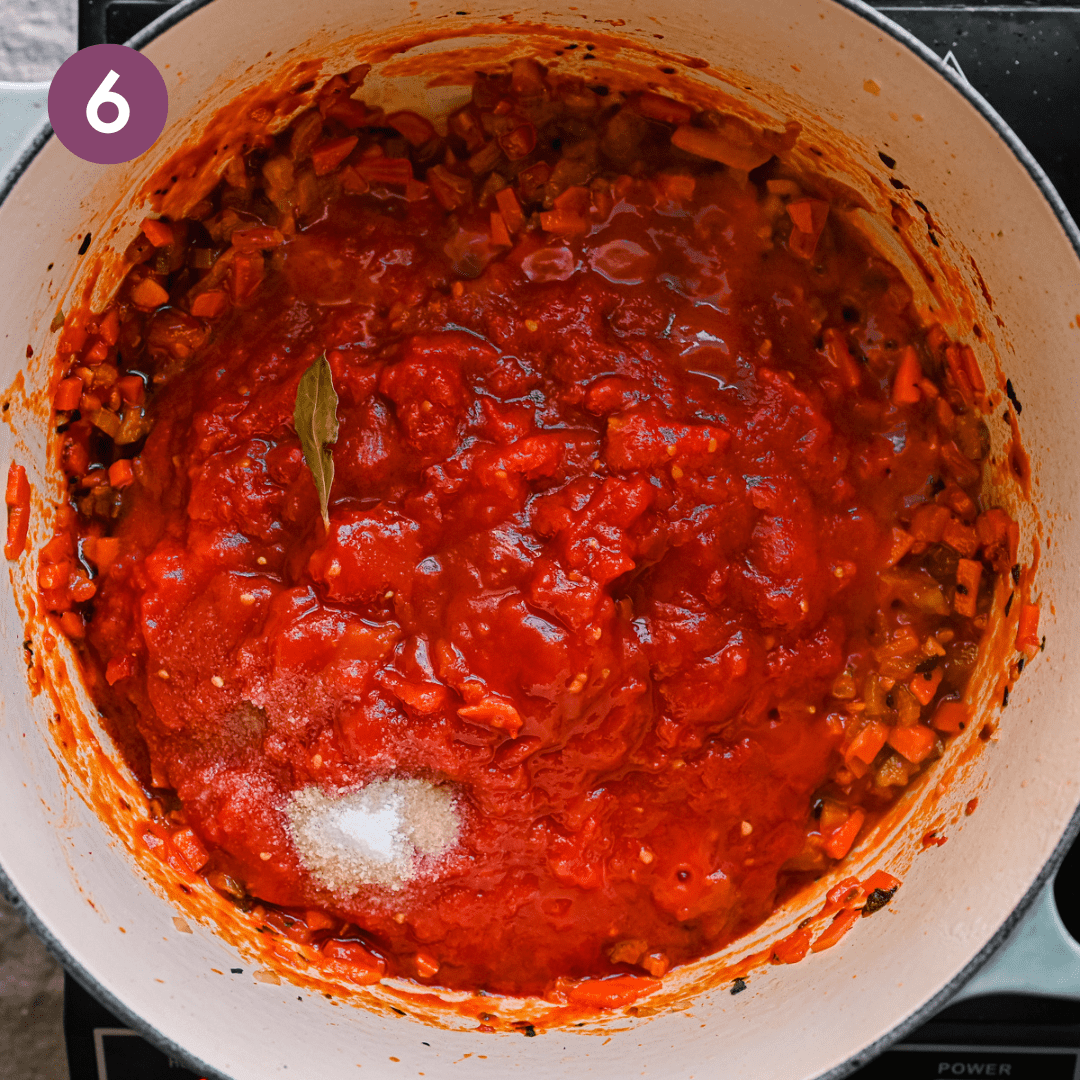
Cook at a rapid simmer, until most of the tomato liquid has evaporated, 12 to 13 minutes.
Then pour in the cannellini beans and vegetable broth.
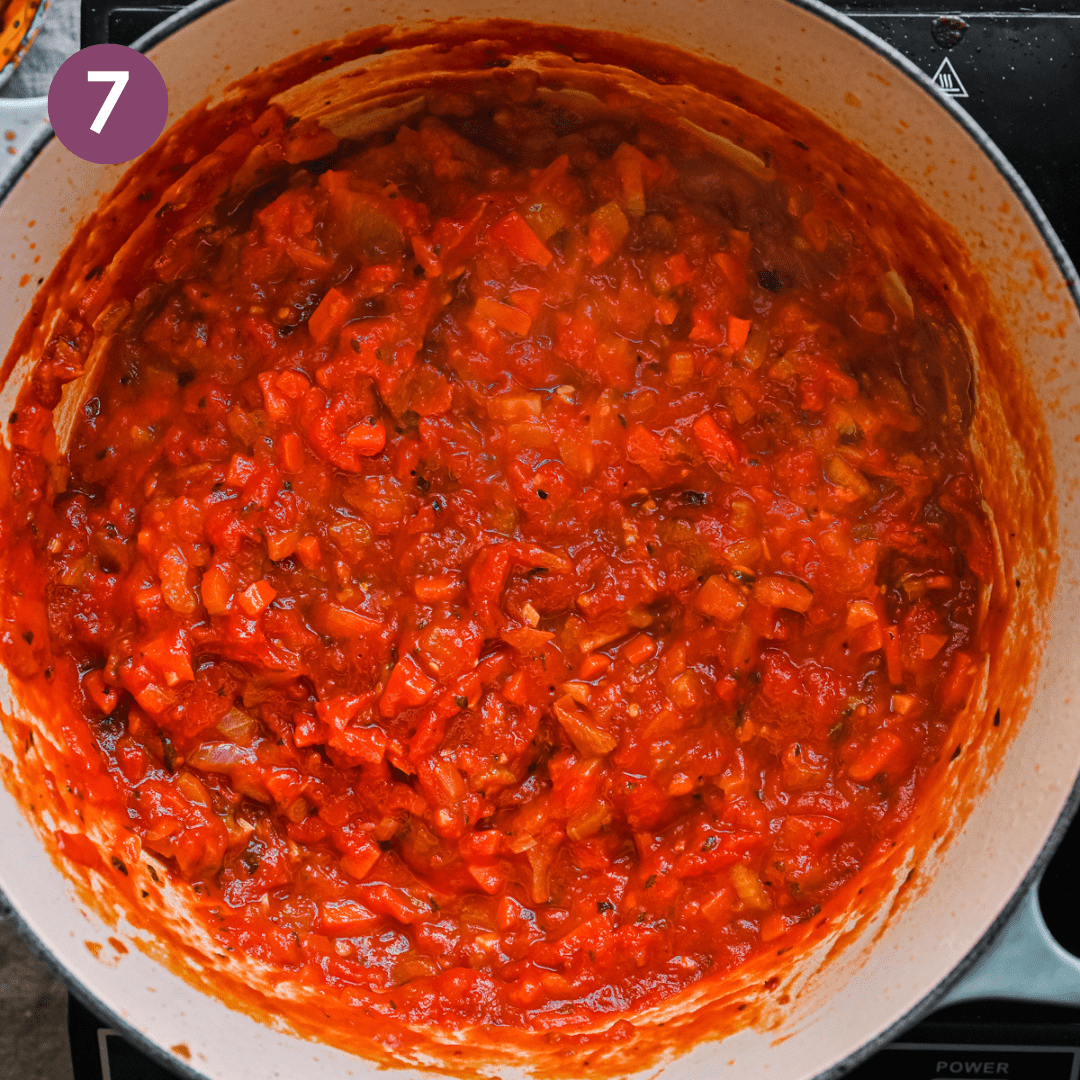
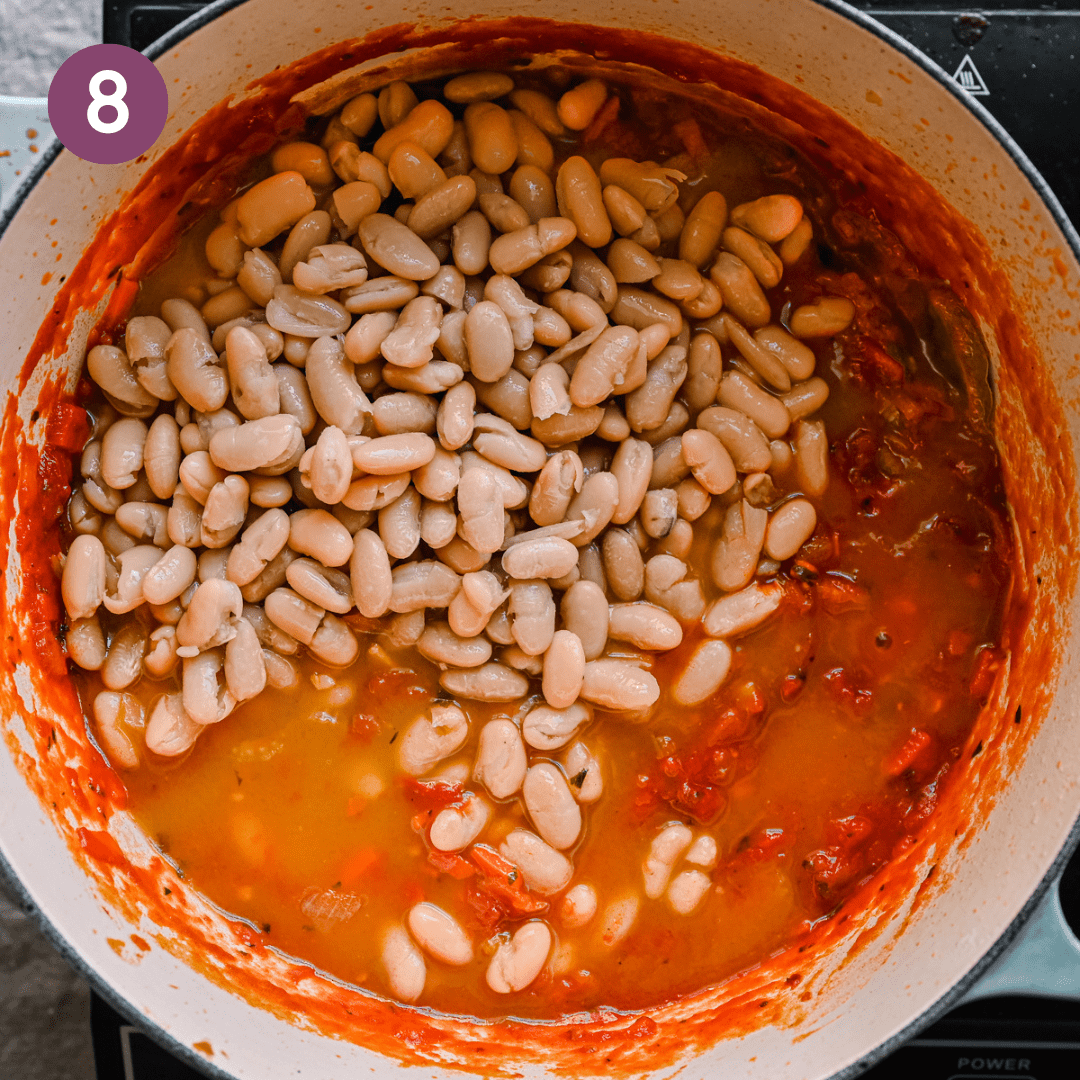
Stir to combine, and simmer covered for 30 minutes, stirring occasionally.
Stir slivered basil into the finished stew.
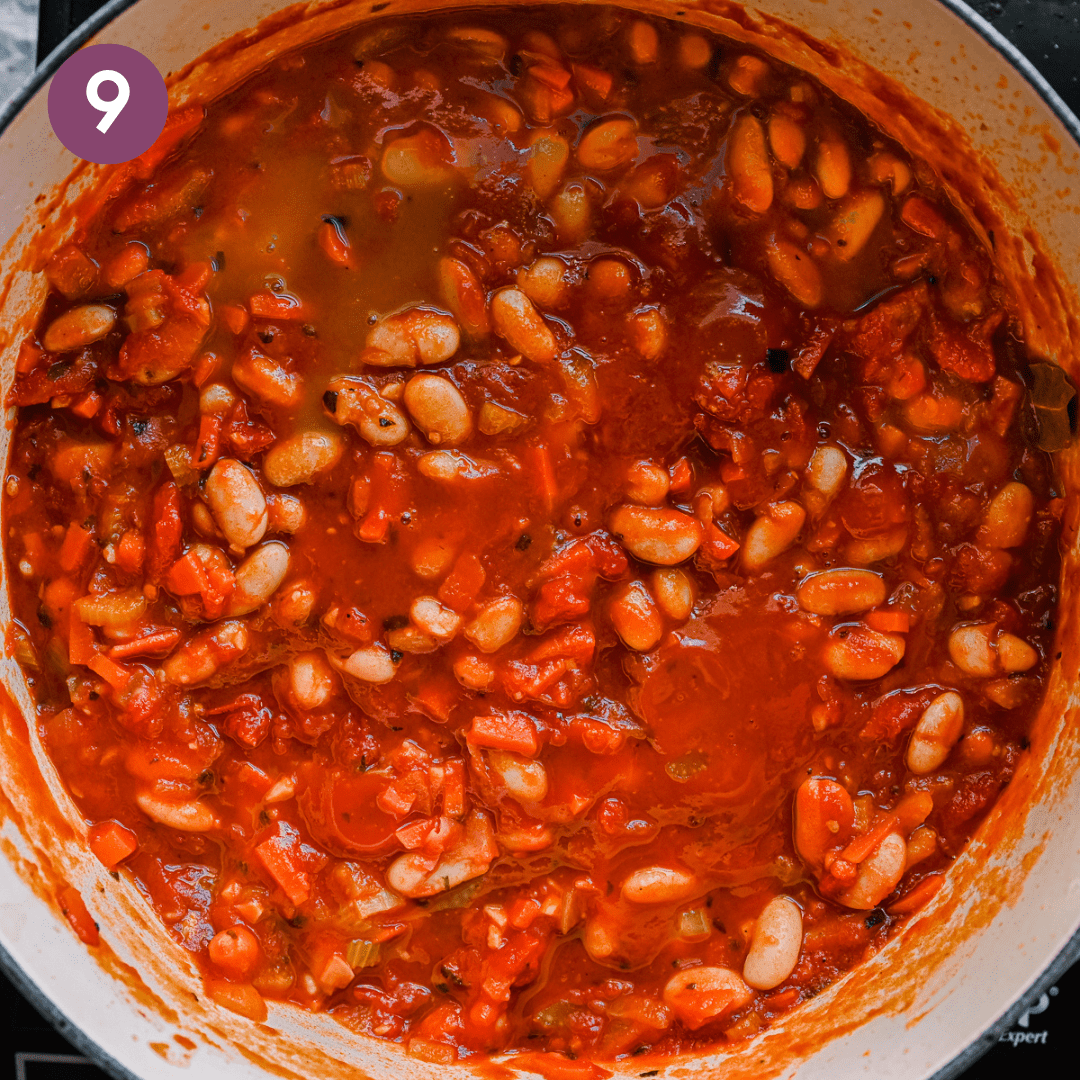
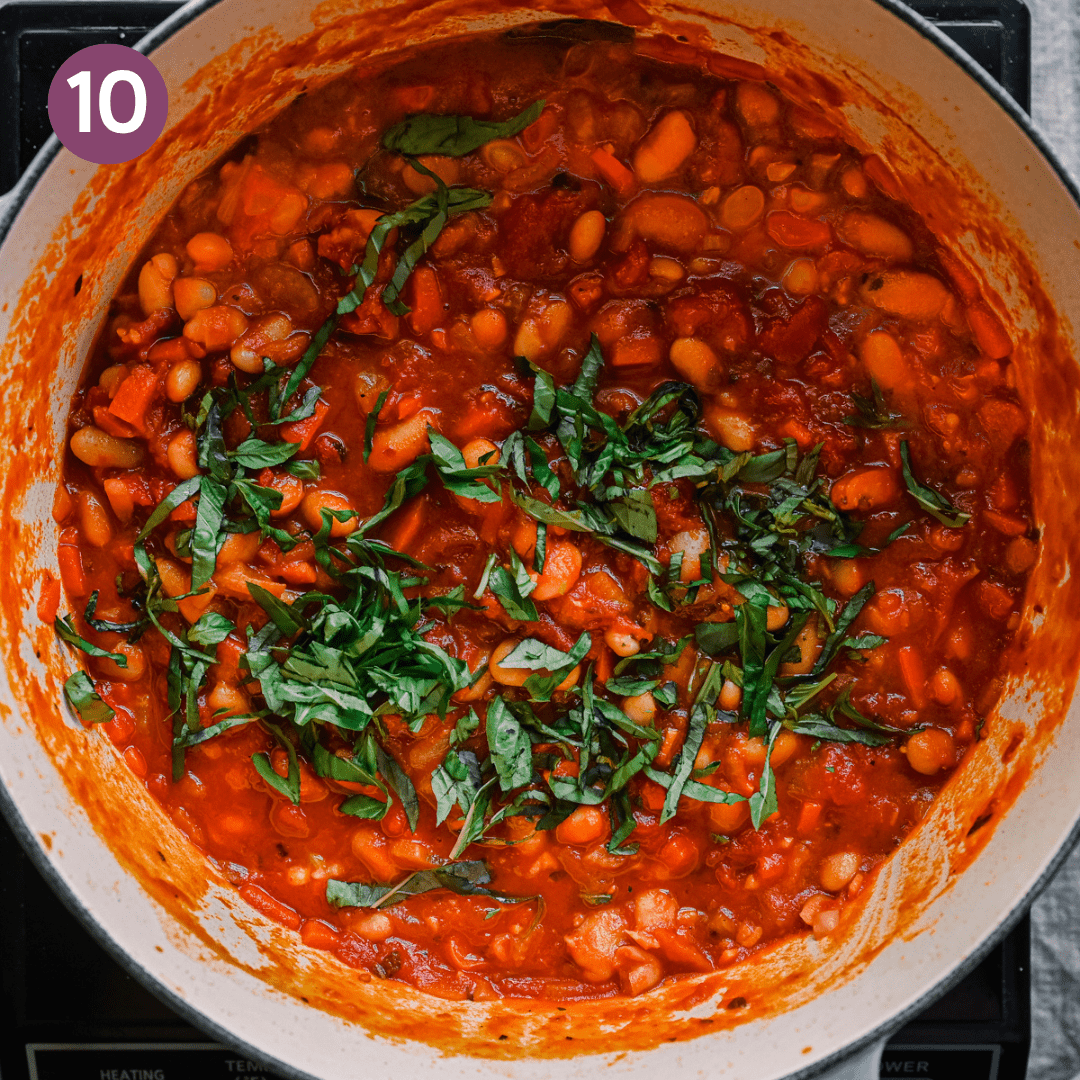
Tips for making this recipe
For the best results, use the best tomato products you can find.
You’ll get the best results if you use (1) whole peeled canned tomatoes (our favorite brands are Bianco Napoli, San Merican, and Cento) and (2) tomato paste from a tube (Amore is our favorite supermarket brand; affiliate link).
If it sounds like I’m making up arbitrary rules, I promise I’m not! When you’re making a recipe with very simple ingredients like this, using the best-quality ingredients available to you is key.
If your tomatoes are quite acidic, you might need to add a pinch of sugar at the end (taste first, then adjust as needed).
Don’t skimp on the olive oil.
Extra virgin olive oil is key in any good Tuscan recipe, and I wanted to stay true to that. Plus, it’s the only source of fat here, and honestly, it makes a big difference.
The olive oil allows the onions to get super sweet and to unleash their umami without the edges browning or burning, so the onions almost melt into the stew. And it adds a rich, luxurious mouthfeel to the whole stew that is absolutely divine.
Modify to your preferred texture.
These stewed beans are supposed to be thick and velvety in texture, but if you prefer a looser consistency, feel free to add 1/2 to 1 cup (120 to 240 mL) of additional broth (or water).
Frequently Asked Questions
You can try white grape juice (a no-sugar-added variety) but use about half the amount, as it’s sweeter than wine.
Or, you can try 1/2 cup (120 mL) veggie broth + 2 tablespoons white wine vinegar mixed together. You’ll get similar flavors with these substitutes, just not as much complexity of flavor.
Sure! A very appropriate addition would be lacinato kale (AKA Tuscan kale). Chop it finely and add it to the last 5 minutes of the stew, cooking it down until it wilts.
Store in an airtight container for 5 to 6 days. I prefer to reheat in a saucepan on the stove (medium heat), but you can also reheat in the microwave.
Absolutely! This recipe freezes great. Once it’s cool, transfer to a few small containers (makes it quicker to defrost). It should stay good in the freezer for 4 months.
I like using these single-serve Souper Cubes (affiliate link). It makes it easy to defrost an individual block of the stew on the stove in less than 10 minutes. Or, you can defrost the stew in the fridge.
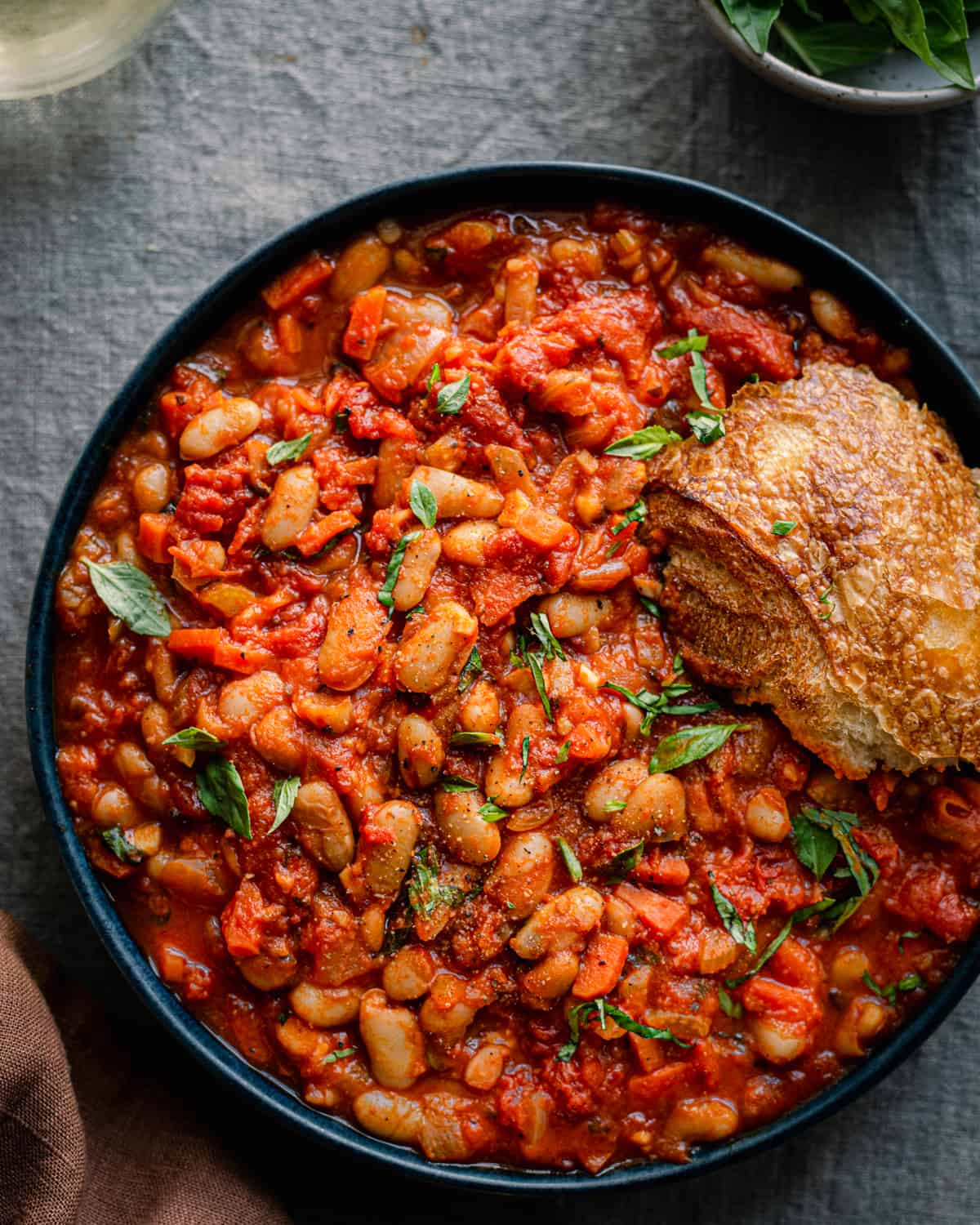

Big Vegan Flavor
Techniques and 150 recipes to master vegan cooking.

Introducing
Big Vegan Flavor
Techniques and 150 recipes to master vegan cooking.
Tuscan Stewed Beans

Ingredients
- 1/4 cup (56 mL) extra virgin olive oil
- 1 medium yellow onion, chopped
- 2 medium or large carrots, peeled and finely chopped
- 2 celery ribs, diced
- 4 garlic cloves, finely chopped
- ½ tsp red pepper flakes
- 1/4 cup (4g) flat-leaf parsley leaves and tender stems, minced
- 1 tablespoon minced fresh sage
- 4 1/2 tablespoons (67g) tomato paste (in a tube, not a can)*
- ¾ cup (180 mL) dry white wine**
- 1 28-ounce (800g) can whole peeled tomatoes, crushed by hand
- 1 teaspoon kosher salt, plus more to taste
- Freshly cracked black pepper
- 1 bay leaf
- 1 1/2 cups (360 mL) vegetable broth, plus more as desired
- 2 (15-ounce/425g) cans cannellini beans, drained and rinsed
- ½ cup (8g) fresh basil, slivered***
Instructions
- Heat the olive oil in a Dutch oven over medium heat. Once the oil is hot, add the onion, and season with a pinch or two of salt and pepper. Cook for 7 to 8 minutes, until golden, stirring occasionally. Add in the carrot, celery, and garlic, with another pinch of salt and cook for 3 to 4 minutes. Add the red pepper flakes, parsley, and sage and cook until fragrant, about 1 minute.
- Add the tomato paste and cook, stirring almost continuously, for 1 to 2 minutes, until it's a bit darker in color.
- Pour the white wine in and deglaze the pan, scraping up any browned bits stuck to the bottom of the pot. Allow wine to simmer rapidly for 3 minutes, or until mostly evaporated and it no longer smells like wine, stirring often.
- Add tomatoes along with their juices, bay leaf, 1 teaspoon kosher salt, and several cracks of black pepper. Cook at a rapid simmer, stirring fairly often, until the tomatoes are fully broken down and most of the liquid has evaporated, 12 to 13 minutes.
- Add the veggie broth and 2 cans of beans. Reduce the heat to low, cover the pan, and maintain a decent simmer for 30 minutes, stirring once in a while. If you want the stew to be thicker, towards the end of cooking, use the back of a wooden spoon or a spatula to gently smash a small portion of the beans.
- Taste, adding a pinch of sugar if needed (if your tomatoes are good-quality, it should not be necessary). Remove the bay leaf. Finish with chopped basil. Season to taste, adding salt and pepper as needed.
Video
Notes
Nutrition
Nutrition information is automatically calculated, so should only be used as an approximation.


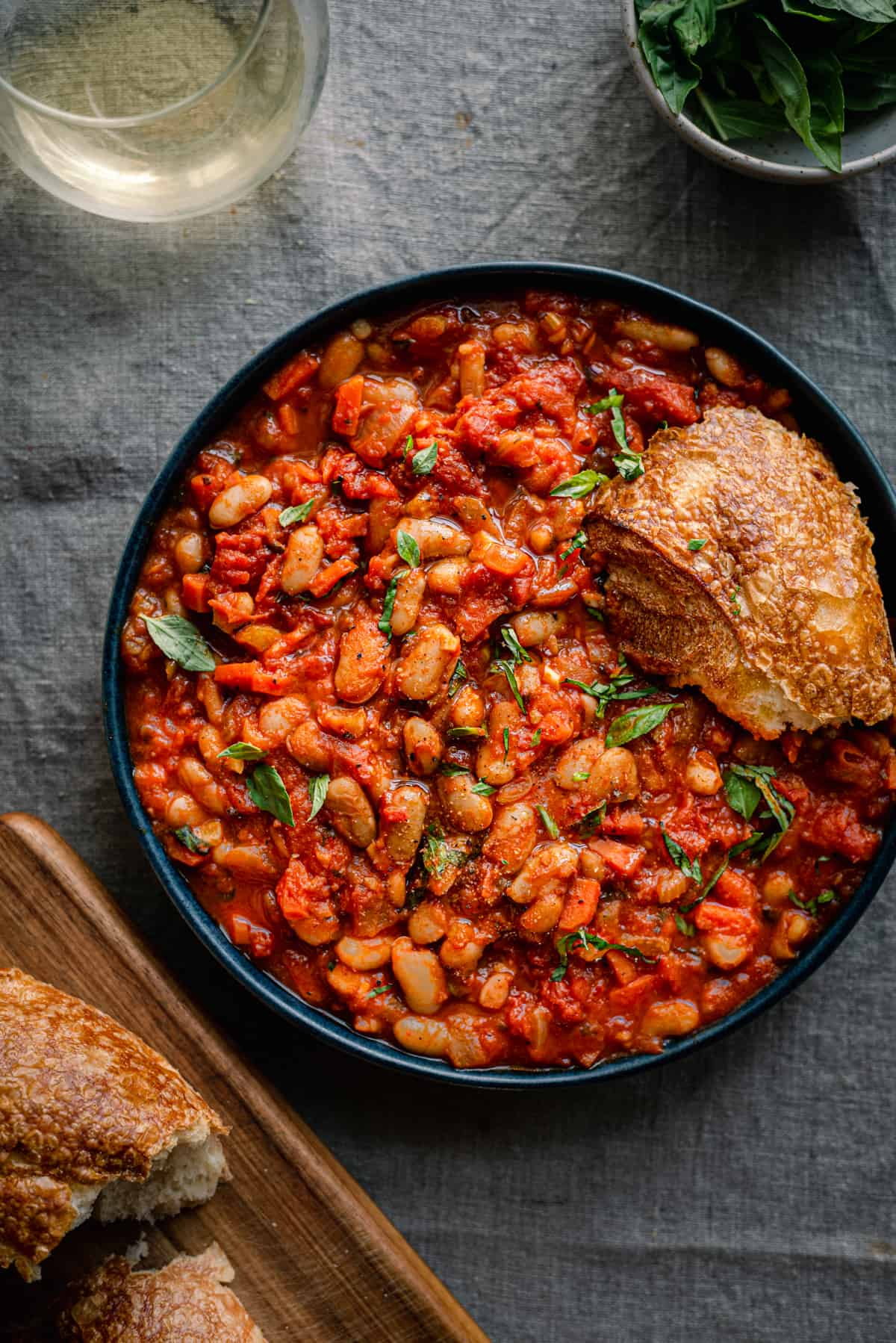













Delicious!
It’s practically a store cupboard recipe, and it’s very easy to halve everything for two portions.
I used dried sage, and a can of high quality chopped tomatoes (checked ingredients: tomatoes and tomato juice, end).
Keep the oily measuring tablespoon for measuring the tomato puree (paste). The oil stops the tomato sticking to the spoon.
Just made it, it was absolutely delicious and heart warming. Only thing I did differently was do half veg stock, half chicken, and added parmasean cheese as a thickener. Really enjoyed it and will make again. Took me about 2.5 hours from start to finish. Ate with some toasted bread, so tasty! 🥖
Good to hear you enjoyed the recipe, Olivia!
This stew is magic! It was a revelation to me that you can make something so delicious using only vegetables. It’s my go-to as soon as the weather turns cool (but I often make it in summer too, so I can use it for lunch throughout the week). We don’t eat exclusively vegan but this stew started us on our journey of eating vegan a few days a few week. Coming from a culture that eats a lot of meat, I always thought eating vegan had to be a huge sacrifice where all your food tasted cardboard for the good of the environment, but this stew (and really all the recipes here) showed me that simply isn’t true!
I have made this stew at least once a month for years now, so I figured it’s long past due for me to write a review.
Your review made our day, Elre! Thank you for taking the time to share your story and for trying out the recipe.
Hi, I’m excited to make this recipe! A vegetarian friend I’d like to try it with doesn’t like onions of any type. Do you have any recommendations about substitutions? Thank you!
Hi Amy! I’m not sure if your friend likes leeks, but they would be a fantastic substitute here. I’d use two small/medium or 1 large leek and slice into rings. Leeks are quite dirty, so first add them to a bowl of cold water, swish them around with your hands to loosen any dirt, and then scoop them out of the water using your hands or slotted spoon.
This dish was delicious, só flavourful and comforting. The second helping of my friend was much bigger than the first. He said he would like to finish the rest of the stew the week…. So good he would eat it again and again
We’re over the moon to hear you two enjoyed the recipe, Tertia. Thanks for your kind words!
Need to try this asap!!
Hope you enjoy this recipe, Elise!
This was very good, but does take awhile to cook! I am a sucker for a saucy dish to dip crusty bread in, though! I was lazy and skipped the white wine and bought diced tomatoes, and it didn’t thicken as much as the photos in this recipe. A better lazy option probably would’ve been crushed tomatoes. Oh I also doubled the carrots and skipped the celery since I didn’t want to buy a whole thing of celery, which I’m sure meant it wasn’t as tasty, and if I did it again, I’d either just use celery or only add 1 extra carrot. So my recommendation is to follow the recipe, but if you’re lazy like me, it will still be pretty tasty!
We appreciate your feedback and support, Kim. Thank you for leaving a review!